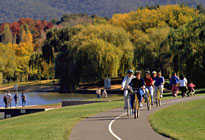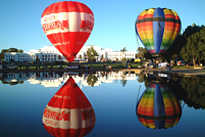Australian Capital Territory
Home to the entire nation’s capital city, Canberra, and Parliament House, the Australian Capital Territory is a focal point for government and law.
Over half the total area of the ACT is covered in beautiful national parks and forest. An alpine region lies in the southwest of the territory, with mountains that become capped with snow in winter.
key facts
- Location: Within the NSW borders, halfway between Sydney and Melbourne
- Population: 390,000
- Size: 2,358 km2
weather
Canberra’s climate is dry and continental, though it can be remarkably cold in winter.
- Summer average: 18–21°C
- Winter average: 3–6°C
- Average rainfall: 400–600 mm
local economy

The ACT has a thriving tourism industry, thanks to being home to some of Australia’s most well known landmarks, such as the Australian War Memorial and Parliament House (which is the focal point of the Australian Commonwealth Government).
The ACT has a highly educated workforce and the highest per capita income in Australia.
Meanwhile, Canberra has a booming construction industry and public sector, with over 50% of the employment in the ACT being within the public service and defense sectors.
about the australian capital territory
The ACT is Australia’s smallest self-governing territory, spanning less than 3,000 km2.
A three hour drive from Sydney, the territory itself sits within New South Wales, although it has its own separate territory government.
The ACT is built on Ngunnawal country. The Indigenous Ngunnawal people populated the region for approximately 21,000 years prior to the European settlement in the 1820s and their artefacts can be found in Tidbinbilla Nature Reserve and Namadgi National Park.

about canberra
Canberra is Australia’s purpose-built national capital, after it was decided in 1908 that a different site outside of Sydney or Melbourne was needed.
An international competition was held to design the new capital city and over 130 entries were made.
The resulting city that we see today is built around the man-made Lake Burley Griffin, and has come to house a number of iconic national landmarks including the Australian War Memorial, Parliament House and the National Library of Australia.


